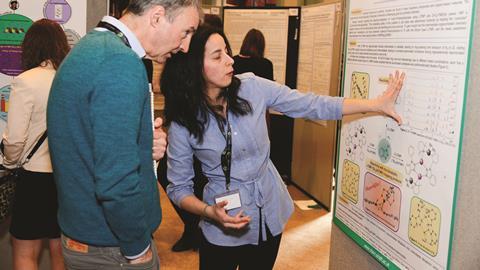The do’s and don’ts of impressing with your research
Scientific posters are a great way to engage colleagues at conferences, providing a visual route into research. They can be used to facilitate discussions, spark new ideas, and introduce scientists to areas of research they are unfamiliar with. But while producing a good poster may seem like child’s play, in reality it takes a considerable amount of effort to pull off.
We spoke to Matthew Baker, chemistry lecturer at the University of Strathclyde, and Craig Banks, professor of electrochemical and nanotechnology at Manchester Metropolitan University, who co-organise the RSC’s Twitter poster conference series. Alongside judge Karen Faulds, a professor of chemistry also from the University of Strathclyde, they told us what they believe makes the perfect poster.
Be succinct
Top of all the experts’ lists is not to cram your poster with too much detail. Banks adds that all posters should be thought of as a sales pitch – simple and to the point. A common mistake is to regurgitate a scientific paper; posters should be used to get across the excitement of the research and draw people in, not to give all the data on your work. ‘Take your best example and use that to illustrate,’ suggests Banks.
This applies to words as well as content, say Baker and Faulds, who both agree that lots of text on posters is a big no-no. ‘Don’t be shy about limiting text,’ says Baker. ‘You’re there to talk about [the research]and engage people.’ His advice is to use bullet points and no continuous prose – this will also help you to think through what is the most important information to include. ‘Seeing a whole block of text is quite off-putting,’ agrees Faulds. She suggests that figure captions might be a good place to include extra experimental details without overloading your poster too much.
Remember the visuals
Your poster is your calling card, so pay attention to how it looks – you will need images and graphics to describe your work without words. And don’t be afraid to think creatively: some of the posters submitted to the team’s Twitter competition used cartoons to great effect.
Even in the most traditional poster competition, there might be an interesting way to put across your point. ‘For me it is not possible to be too creative,’ says Baker. ‘If it conveys the scientific point in simple, creative, visual manner, that’s the best you could hope for.’
Lose the fuzz
Always ensure that any diagrams are of the correct resolution when blown up to poster dimensions – fuzzy figures were one of our experts’ top gripes.
Other mistakes to avoid include diagrams crammed with information, tiny text or colours that are hard to read. ‘Size is important,’ says Faulds. ‘If you’re trying to view [the poster] you have to be able to see without squinting.’ Another issue is ‘thinking you have to fill all of the sheet – space is fine’, says Banks.
Baker advises paying close attention to the conference poster requirements. Is your poster portrait when they have requested a landscape format? And while software packages usually pick up spelling and grammar mistakes, you still need to proofread your poster before submission. Errors can discredit your work.
Pitch it correctly
‘Think about your audience,’ says Faulds. ‘If you’re at a Raman spectroscopy conference you don’t need to explain the technique.’ However, if you’re at a biology conference, you might.
With many researchers now working in interdisciplinary environments, be prepared to adapt your poster content depending on who you are addressing and the knowledge they hold. Baker tells of posters that are simply PowerPoint slides rearranged into poster format – avoid this at all costs.
Speak up
Often, what tips a poster from good to prize-winning is not what’s on the piece of paper – it’s you. How you answer questions and explain your work is an integral part of presenting a scientific poster. ‘Students presenting should always have prepared a one-minute explanation of their poster,’ says Faulds. Banks adds that you might like to have a separate handout to take away – providing more scientific information than you included on the main presentation. ‘Don’t be shy to grab people,’ says Baker.
According to Faulds, as well as being able to discuss the work knowledgably, enthusiasm is something she looks for when judging, whether it is a first year student presenting what they plan to do or a third year demonstrating their results at the end of their PhD.
And while it’s tempting to wander off and see what else is happening, keep in mind that not standing near your poster can hurt your chances: potential prize winners have lost out in close competitions because the other presenter was there to answer questions.













No comments yet